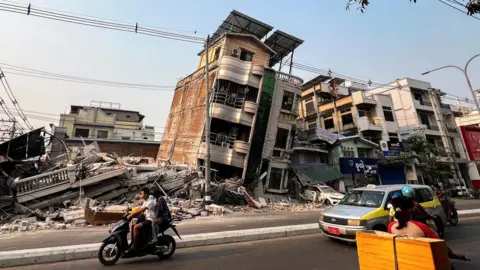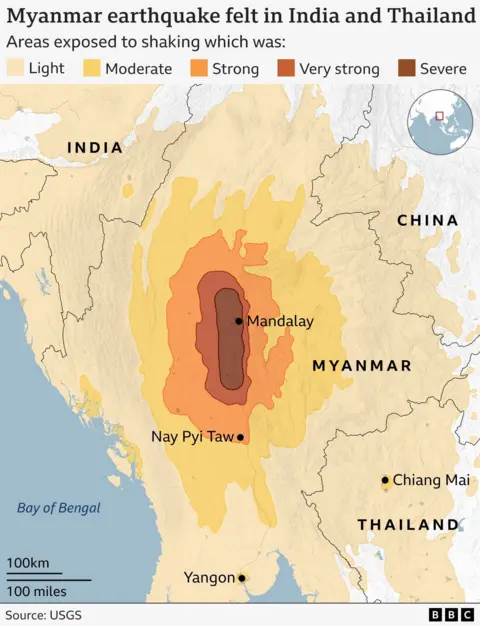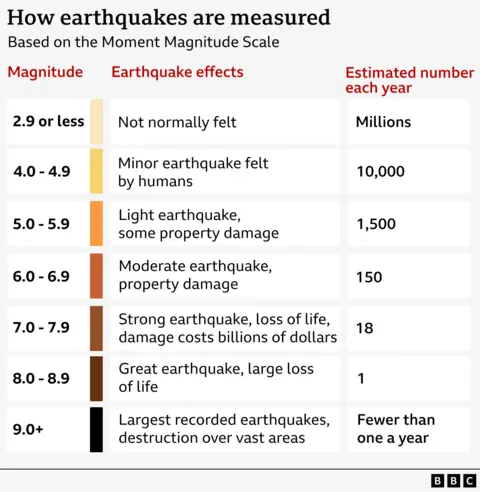Myanmar earthquake: What we know
 Reuters
ReutersMyanmar is reeling following the huge earthquake which hit the country on Friday, 28 March.
The magnitude-7.7 tremor was felt elsewhere, including in Thailand and south-west China.
More than 1,700 people have died and more than 3,400 have been injured, say the leaders of the country's military government. In Thailand, at least 18 lost their lives.
Here is what we know so far.
Where did the earthquake strike?
The earthquake's epicentre was located 16km (10 miles) north-west of Myanmar's city Sagaing, the US Geological Survey (USGS) said.
This is also near Myanmar's second-largest city, Mandalay, with a population of about 1.5 million people - and about 100km (60 miles) north of the capital, Nay Pyi Taw.
The first earthquake struck at about 12:50 (06:20 GMT), according to the USGS. A second earthquake struck 12 minutes later, with a magnitude of 6.4. Its epicentre was 18km (11 miles) south of Sagaing.
Aftershocks have continued since - the latest on Sunday was a magnitude-5.1 tremor north-west of Mandalay, with a resident telling BBC Burmese it was the strongest they had felt since 28 March.
Which areas were affected?

The strong quake buckled roads, damaged bridges and flattened many buildings in Myanmar (formerly known as Burma) - a country of some 55 million people.
It is considered one of the world's most geologically "active" areas.
The ruling junta said 1,591 houses had been damaged in the Mandalay region. Scores of people remain trapped with rescuers searching "with bare hands".
Strong tremors were also felt elsewhere, including in Thailand and south-west China.
The Thai capital, Bangkok, sits more than 1,000km (621 miles) from the epicentre of Friday's earthquake - and yet an unfinished high-rise building in the city was felled by it.
Videos also showed rooftop pools in Bangkok spilling over the sides of swaying buildings.
How deadly was it?
The official death toll now stands at 1,700. Many of the fatalities were in Mandalay.
More than 3,400 people were injured and 300 are missing.
The US Geological Survey's modelling estimates Myanmar's death toll could exceed 10,000, with losses surpassing annual economic output.
Rescue operations are ongoing, with one rescue team in Mandalay saying they were "digging people out with our bare hands".
Meanwhile, in Bangkok, 18 people have been confirmed dead - 11 of them at the high-rise building (10 died at the scene, one died at the hospital), where 78 remain missing.
How hard is it to find out what's happening in Myanmar?
Getting information out of Myanmar is difficult.
Myanmar has been ruled by a military junta since a coup in 2021, complicating access to information.
The state controls almost all local radio, television, print and online media. Internet use is also restricted.
Mobile lines in the affected areas have been patchy, but tens of thousands of people also live without electricity, making it difficult for the BBC to reach residents.
Foreign journalists are rarely allowed into the country officially.
What aid is reaching Myanmar?
Some international aid - mainly from China and India - has begun to arrive after the military authorities issued a rare appeal.
Aid has also been sent from Thailand, Malaysia, Singapore and Russia.
Rescuers from several countries have joined the local efforts to locate and pull put any survivors.
The Red Cross has issued an urgent appeal for $100m (£77m).
How is the conflict affecting relief efforts?
The NUG has announced that its armed wing, the People's Defence Force (PDF), will pause "offensive military operations" for two weeks in earthquake-affected areas, except for "defensive actions."
Anti-coup PDF battalions have been fighting the military junta since the latter seized power in 2021.
The pause is set to begin on Sunday, but its impact is uncertain as many ethnic armed groups act independently of the NUG.
Meanwhile, the junta has continued airstrikes in some areas, with the UN condemning them as "completely outrageous and unacceptable."
What causes earthquakes?
The Earth's crust is made up of separate bits, called plates, that nestle alongside each other.
These plates often try to move but are prevented by the friction of rubbing up against an adjoining one.
But sometimes, the pressure builds until one plate suddenly jerks across, causing the surface to move.
They are measured on a scale called the Moment Magnitude Scale (Mw). This has replaced the Richter scale, which is now considered outdated and less accurate.
The number attributed to an earthquake represents a combination of the distance the fault line has moved and the force that moved it.
A tremor of 2.5 or less usually cannot be felt but can be detected by instruments. Quakes of up to five are felt and cause minor damage. The Myanmar earthquake at 7.7 is classified as major and usually causes serious damage, as it has in this instance.
Anything above 8.0 causes catastrophic damage and can totally destroy communities at its centre.

Is it safe to travel to Myanmar, Thailand or Laos?
The UK's Foreign, Commonwealth & Development Office (FCDO) has warned about the possibility of several strong aftershocks in places affected by the earthquake.
It has advised people in the area, or tourists planning to travel to Myanmar, Thailand or Laos, to monitor local media and follow the advice of local authorities and tour operators.
The FCDO has also previously issued advice against travel to parts of Myanmar and all but essential travel to parts of Thailand and Laos.
Myanmar's security situation "may deteriorate at short notice and the military regime can introduce travel restrictions at any time" amid an "increasingly volatile" conflict, it said.
The FCDO's warning for parts of Thailand is "due to regular attacks in the provinces by the border with Malaysia" and its advice for Laos relates to "intermittent attacks on infrastructure and armed clashes with anti-government groups" in Xaisomboun province.
How does this compare with other large earthquakes?
This earthquake and its aftershocks were relatively shallow - about 10km in depth.
That means the impact on the surface is likely to have been more devastating than a deeper earthquake, with buildings shaken much harder and more likely to collapse.
On 26 December 2004, one of the largest earthquakes ever recorded struck off the coast of Indonesia, triggering a tsunami that swept away entire communities around the Indian Ocean. That 9.1 magnitude quake killed about 228,000 people.
The largest ever earthquake registered 9.5 and was recorded in Chile in 1960.
